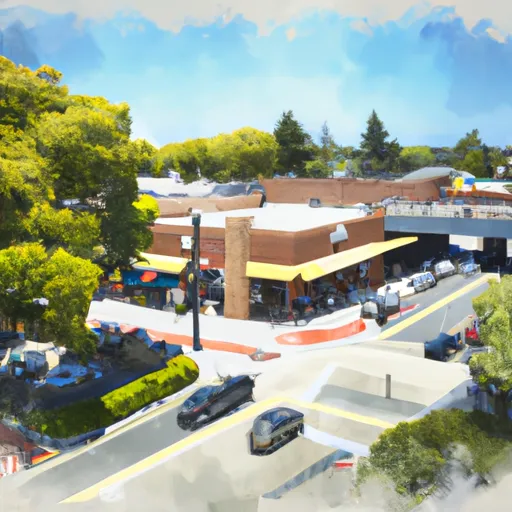-
 Snoflo Premium
Snoflo Premium
Get unlimited access to all our content
With no Ad interruptions! - Start Your Free Trial Login with existing account
Millbrae
Eden Index
Climate
8.0
•
Recreation
3.1
•
Community
7.1
•
Safeguard
6.1/10

Millbrae, California is a city located in San Mateo County, in the San Francisco Bay Area. It enjoys a pleasant Mediterranean climate characterized by mild, wet winters and dry, warm summers. The average temperature ranges from 50°F (10°C) in winter to 70°F (21°C) in summer. The city experiences frequent fog, particularly during the summer months, which provides a cool relief from the heat.
Millbrae is not known for any significant hydrological features such as rivers or lakes. However, it is located near the San Francisco Bay, which offers various water-based activities like boating, kayaking, and fishing.
Outdoor recreation opportunities in Millbrae and its surrounding areas are abundant. The city is home to several parks, including Green Hills Park, which offers scenic trails for hiking and biking, as well as picnic areas. Nearby, San Bruno Mountain State and County Park provides stunning views, hiking trails, and opportunities for birdwatching. For golf enthusiasts, the Green Hills Country Club offers a challenging course.
Overall, Millbrae's climate, lack of major hydrological features, and proximity to parks and the San Francisco Bay offer residents and visitors ample opportunities for outdoor recreation and enjoyment.
What is the Eden Index?
The Snoflo Eden Index serves as a comprehensive rating system for regions, evaluating their desirability through a holistic assessment of climate health, outdoor recreation opportunities, and natural disaster risk, acknowledging the profound impact of these factors on livability and well-being.
Climate Health Indicator (CHI): 8.0
Millbrae receives approximately
584mm of rain per year,
with humidity levels near 87%
and air temperatures averaging around
15°C.
Millbrae has a plant hardyness factor of
10, meaning
plants and agriculture in this region tend to thrive here all year round.
By considering the ideal temperature range, reliable water supplies, clean air, and stable seasonal rain or snowpacks, the Climate Health Indicator (CHI) underscores the significance of a healthy climate as the foundation for quality living.
A healthy climate is paramount for ensuring a high quality of life and livability in a region, fostering both physical well-being and environmental harmony. This can be characterized by ideal temperatures, reliable access to water supplies, clean air, and consistent seasonal rain or snowpacks.
Weather Forecast
Streamflow Conditions
San Francisco Bay
Area Rivers
San Francisco Bay
Snowpack Depths
San Francisco Bay
Reservoir Storage Capacity
San Francisco Bay
Groundwater Levels
Recreational Opportunity Index (ROI): 3.1
The Recreational Opportunity Index (ROI) recognizes the value of outdoor recreational options, such as parks, hiking trails, camping sites, and fishing spots, while acknowledging that climate plays a pivotal role in ensuring the comfort and consistency of these experiences.
Access to outdoor recreational opportunities, encompassing activities such as parks, hiking, camping, and fishing, is crucial for overall well-being, and the climate plays a pivotal role in enabling and enhancing these experiences, ensuring that individuals can engage in nature-based activities comfortably and consistently.
Camping Areas
| Campground | Campsites | Reservations | Toilets | Showers | Elevation |
|---|---|---|---|---|---|
| Butano State Park | 39 | 181 ft | |||
| Portola Redwoods State Park | 53 | 504 ft | |||
| Half Moon Bay State Beach | None | 41 ft | |||
| San Mateo Memorial County Park | 156 | 193 ft | |||
| China Camp State Park | None | 222 ft |
Nearby Fishing
Catastrophe Safeguard Index (CSI):
The Catastrophe Safeguard Index (CSI) recognizes that natural disaster risk, encompassing floods, fires, hurricanes, and tornadoes, can drastically affect safety and the overall appeal of an area.
The level of natural disaster risk in a region significantly affects safety and the overall livability, with climate change amplifying these risks by potentially increasing the frequency and intensity of events like floods, fires, hurricanes, and tornadoes, thereby posing substantial challenges to community resilience and well-being.
Community Resilience Indicator (CRI): 7.1
The Community Resilience Indicator (CRI) recognizes that education, healthcare, and socioeconomics are crucial to the well-being of a region. The CRI acknowledges the profound impact of these elements on residents' overall quality of life. By evaluating educational resources, healthcare accessibility, and economic inclusivity, the index captures the essential aspects that contribute to a thriving community, fostering resident satisfaction, equity, and social cohesion.

